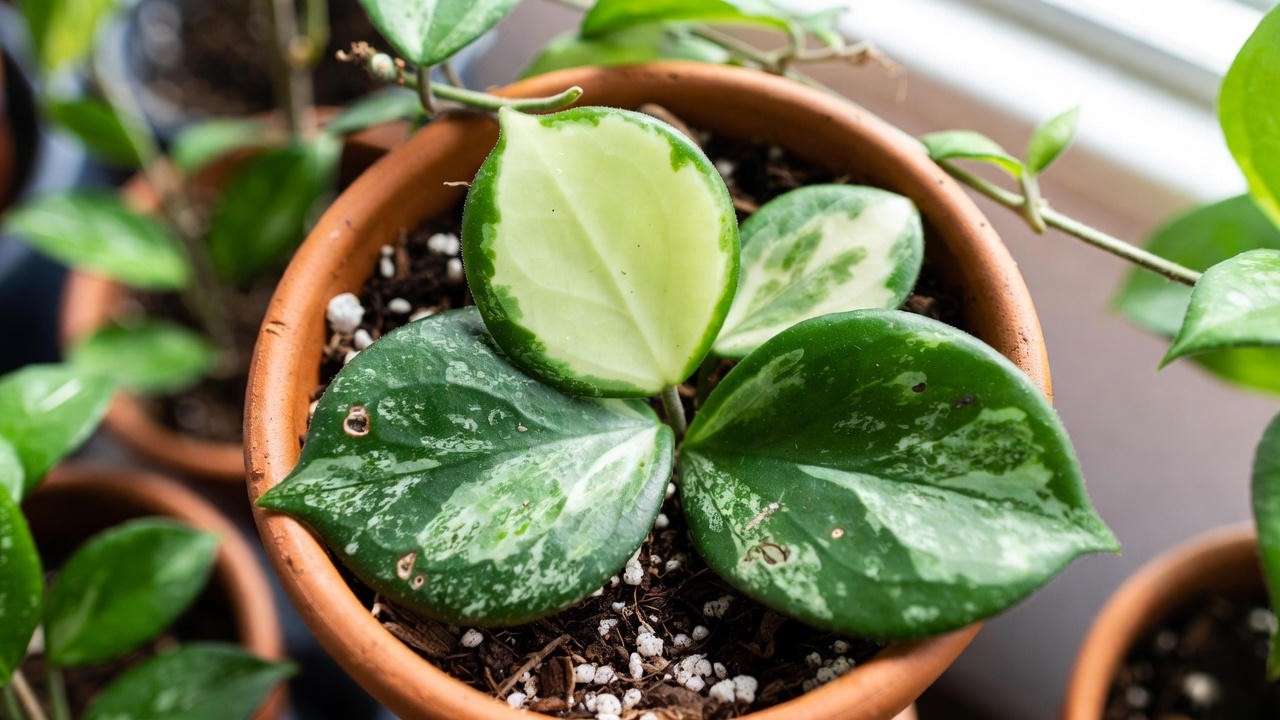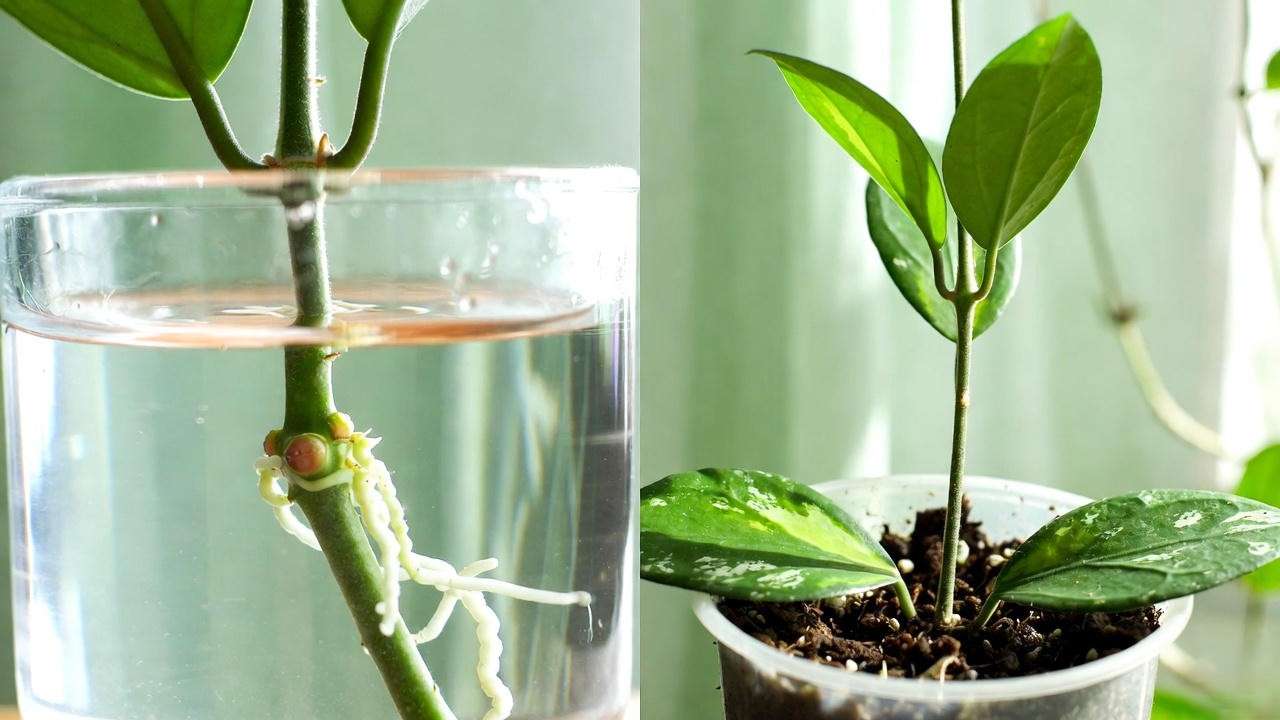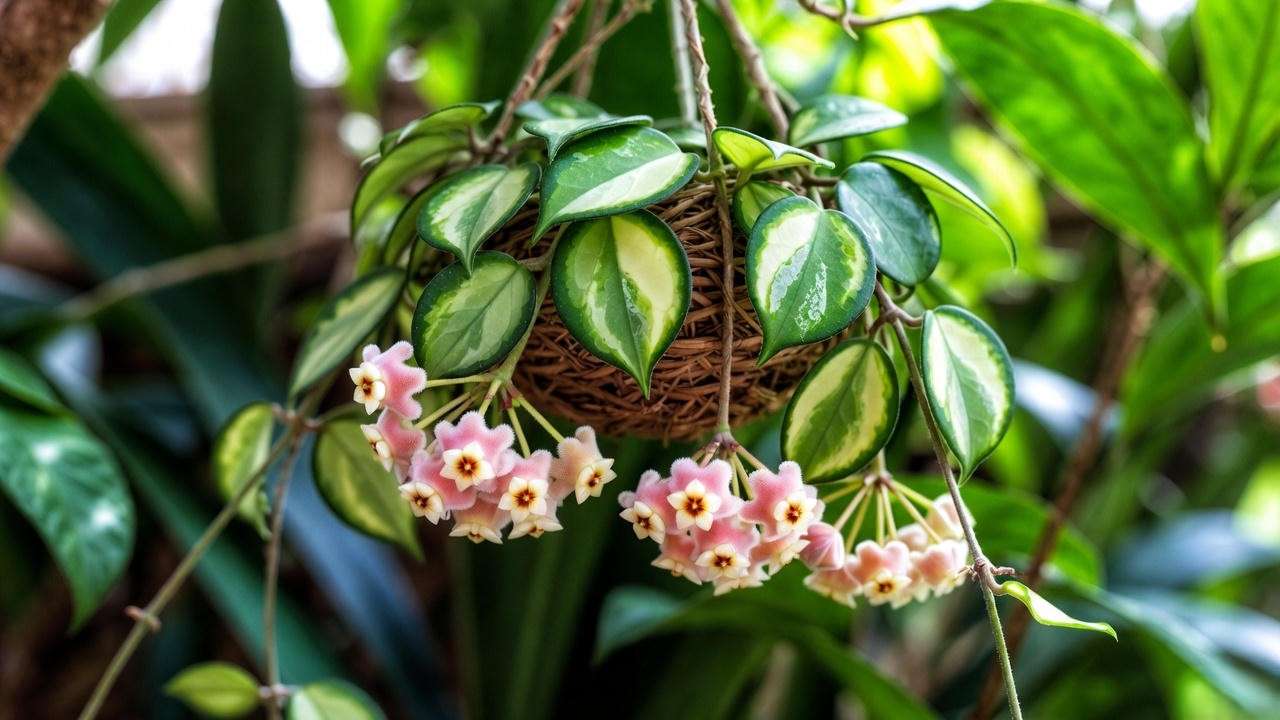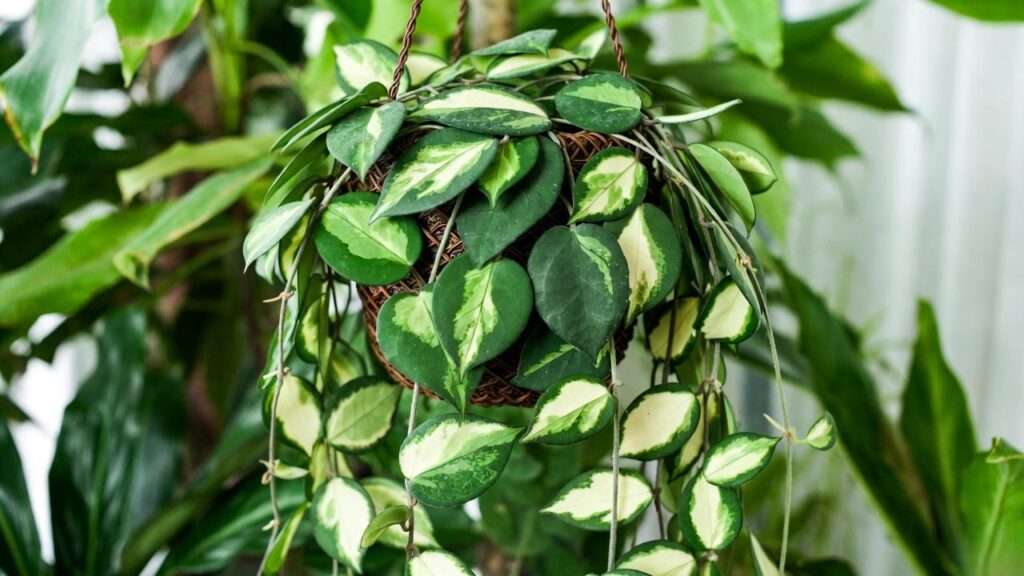Imagine a plant so charming it captures hearts with its lush, heart-shaped leaves splashed with creamy variegation—a perfect blend of beauty and resilience. The variegated heart hoya plant, also known as Hoya kerrii variegata, is a darling of indoor plant enthusiasts, offering stunning foliage with minimal fuss. Whether you’re a seasoned plant parent or a beginner, this guide will empower you to grow a thriving hoya that transforms your space into a green oasis. As a horticulturist with over a decade of experience nurturing tropical plants, I’ve cultivated countless hoyas and learned their secrets. From lighting to propagation, this comprehensive guide covers everything you need to solve common care challenges and keep your variegated heart hoya flourishing. Let’s dive in and unlock the full potential of this sweetheart plant! 🌸
What is a Variegated Heart Hoya Plant? 🌸
Overview of Hoya Kerrii Variegata
The variegated heart hoya plant, scientifically Hoya kerrii variegata, is a succulent-like vining plant native to Southeast Asia. Its thick, heart-shaped leaves, adorned with creamy yellow or white variegation, make it a standout in any plant collection. Unlike its green-leafed cousin, the variegated version boasts a striking contrast that elevates its aesthetic appeal. Often called the “Sweetheart Plant” or “Valentine Hoya,” it’s a symbol of love and devotion, making it a popular gift. This slow-growing epiphyte thrives in hanging baskets or on trellises, with vines that can stretch several feet under ideal conditions. Its waxy leaves store water, making it forgiving for busy plant owners. With proper care, it can even reward you with clusters of star-shaped, fragrant flowers. 🌟
Why Choose a Variegated Heart Hoya?
This plant is a dream for both novice and experienced gardeners. It’s low-maintenance, requiring less frequent watering than many houseplants, and it’s non-toxic, making it safe for homes with pets or children. Its compact size suits small spaces, while its cascading vines add elegance to shelves or hanging planters. In my years of growing hoyas, I’ve found the variegated heart hoya’s resilience remarkable—it thrives despite occasional neglect! Plus, its heart-shaped leaves make it a thoughtful gift for loved ones. Whether you’re building an indoor jungle or seeking a single statement plant, the variegated heart hoya delivers charm and versatility. 🌿
Understanding the Care Needs of Variegated Heart Hoya 🌿
Light Requirements for Vibrant Variegation
Light is the key to maintaining the variegated heart hoya’s stunning foliage. This plant thrives in bright, indirect light, which enhances its creamy variegation without scorching its leaves. Place it near an east-facing window for gentle morning sun or a few feet from a south- or west-facing window with filtered light. If natural light is limited, a grow light (around 10,000–20,000 lux) works wonders. Too much direct sunlight can burn the leaves, causing brown, crispy edges, while too little light fades the variegation, leaving leaves dull. A common mistake is assuming it can thrive in low light—don’t fall for it! Rotate your hoya monthly to ensure even growth. In my experience, a well-lit hoya practically glows with health. 💡
Watering: Finding the Perfect Balance
The variegated heart hoya’s succulent-like leaves mean it doesn’t need frequent watering. Water every 2–3 weeks, allowing the top 2 inches of soil to dry out completely. Use your finger or a moisture meter to check—overwatering is the number one killer of hoyas, leading to root rot and yellowing leaves. If you notice soggy soil or drooping, cut back on watering and ensure proper drainage. Underwatering is less common but can cause shriveled leaves. In winter, reduce watering further as growth slows. I’ve saved many overwatered hoyas by repotting them in fresh, dry soil—patience is key! For best results, use room-temperature water to avoid shocking the roots. 🌊
Soil and Potting: Setting the Foundation
A well-draining soil mix is non-negotiable for a healthy variegated heart hoya. Opt for a cactus or succulent mix blended with perlite or orchid bark to ensure aeration and drainage. You can create a DIY mix with 50% potting soil, 30% perlite, and 20% orchid bark for a budget-friendly option. Choose a pot with drainage holes—terracotta is ideal for its breathability, though ceramic adds a decorative touch. Avoid oversized pots, as hoyas prefer snug conditions. Repot every 2–3 years or when roots crowd the pot. According to the University of Florida’s Extension Service, proper drainage is critical for succulent plants like hoyas to prevent root rot. A well-potted hoya sets the stage for vibrant growth! 🪴

Temperature and Humidity: Mimicking Its Native Environment
The variegated heart hoya loves warm, stable conditions, ideally 60–80°F (15–27°C). Keep it away from cold drafts, air conditioners, or heating vents, which can stress the plant. It tolerates average household humidity (40–60%), but boosting humidity with a pebble tray or humidifier encourages lusher growth, especially in dry climates. In winter, avoid placing it near chilly windows. If you live in a dry region, misting lightly once a week can help, but don’t overdo it—wet leaves invite fungal issues. I’ve found grouping hoyas with other plants creates a natural humidity boost. Mimicking its tropical origins keeps it happy year-round. 🌡️ Word Count: ~110 words
Fertilizing for Healthy Growth
Feed your variegated heart hoya sparingly to support steady growth. Use a balanced, water-soluble fertilizer (like 10-10-10) diluted to half-strength once a month during spring and summer. Over-fertilizing can cause leaf tip burn or salt buildup in the soil, so flush the pot with water every few months to clear excess nutrients. Organic options like compost tea or fish emulsion work well for eco-conscious growers. Stop fertilizing in fall and winter when growth slows. In my experience, a light feeding schedule keeps hoyas vibrant without overwhelming them. Always water before fertilizing to protect the roots. 🌱
Propagation: Growing More Variegated Heart Hoyas 🌱
Step-by-Step Propagation Guide
Propagating a variegated heart hoya is a rewarding way to expand your collection or share with friends. The most effective method is stem cuttings. Follow these steps:
- Select a Healthy Stem: Choose a vine with at least one node (a small bump where leaves grow) and 2–3 leaves.
- Cut and Prep: Use clean scissors to cut below the node. Remove lower leaves to expose the node.
- Root in Water or Soil: Place the cutting in water (change every few days) or a moist, well-draining mix. Roots should form in 2–4 weeks.
- Transplant: Once roots are 2 inches long, pot in a small container with hoya-friendly soil.
- Care for New Plants: Keep in bright, indirect light and water sparingly. Using rooting hormone can speed up the process, but it’s optional. I’ve rooted dozens of hoya cuttings in water with near-perfect success! 🌿

Common Propagation Mistakes to Avoid
Propagation is straightforward, but pitfalls happen. Avoid these mistakes:
- Using Non-Viable Cuttings: Ensure the stem has a node—leaf-only cuttings rarely grow into full plants.
- Overwatering: Keep soil moist, not soggy, to prevent rot.
- Impatience: Rooting can take weeks, so resist checking too often. If roots don’t form, check light and humidity levels. Be patient—hoyas are slow but steady. With care, your cuttings will thrive! 🌱
Troubleshooting Common Variegated Heart Hoya Issues 🩺
Yellowing or Dropping Leaves
Yellowing or dropping leaves are common cries for help from a variegated heart hoya. The usual culprits are overwatering, underwatering, or improper lighting. Overwatering leads to soggy soil and root rot, causing leaves to turn yellow and drop. Check the soil—if it’s wet beyond the top 2 inches, let it dry out and improve drainage. Underwatering results in shriveled, yellow leaves; water thoroughly but sparingly. Insufficient light can also cause leaf drop, as the plant struggles to photosynthesize. Use this checklist:
- Soil Check: Is it too wet or bone-dry?
- Light Audit: Is the plant getting bright, indirect light?
- Pot Inspection: Are roots cramped or rotting? In my experience, repotting an overwatered hoya into fresh, well-draining soil can work wonders. Adjust care, and your plant should recover! 🌿

Pests and Diseases
Variegated heart hoyas are generally pest-resistant, but mealybugs and spider mites can occasionally strike. Mealybugs appear as white, cottony spots on leaves or stems, while spider mites leave fine webbing and stippled leaves. Inspect your plant weekly, especially under leaves. For treatment, wipe leaves with a cloth dipped in diluted neem oil or insecticidal soap. Repeat every 7–10 days until pests are gone. Prevent infestations by keeping leaves dust-free and maintaining good air circulation. Overwatering can invite fungal issues like powdery mildew; ensure proper drainage and avoid wetting leaves. According to Purdue University’s Extension Service, consistent monitoring and early intervention are key to managing houseplant pests. With vigilance, your hoya will stay pest-free! 🐞
Slow Growth or Lack of Variegation
If your variegated heart hoya grows slowly or loses its creamy patterns, it’s likely craving more light or nutrients. Low light dims variegation, making leaves appear greener. Move the plant to a brighter spot with indirect sunlight or use a grow light. Nutrient deficiencies can also stall growth—ensure you’re fertilizing lightly during the growing season. Check for root-bound conditions; repotting into a slightly larger pot can spark new growth. I once revived a sluggish hoya by moving it closer to a window, and within weeks, its variegation popped! Patience is key, as hoyas are naturally slow growers. Keep conditions optimal, and you’ll see progress. 🌱
Encouraging Blooms: Getting Your Hoya to Flower 🌸
The variegated heart hoya’s star-shaped, waxy flower clusters are a rare treat, often pink or white with a sweet fragrance. Blooming requires a mature plant (2–3 years old), bright indirect light, and consistent care. Stressing the plant slightly—such as reducing water slightly in late winter—can trigger blooms, but don’t overdo it. Never cut the flower spurs (peduncles), as they produce future blooms. Ensure nighttime temperatures drop slightly (around 60°F) to mimic natural conditions. In my collection, a hoya bloomed after I left it in a bright, stable spot for a year without fussing—patience pays off! Feed with a phosphorus-rich fertilizer (e.g., 5-10-5) to encourage flowering. With the right conditions, your hoya will reward you with stunning blooms. 🌟

Styling and Displaying Your Variegated Heart Hoya 🏡
The variegated heart hoya’s cascading vines and heart-shaped leaves make it a decorating dream. Display it in a hanging basket to showcase its trailing growth or train it up a small trellis for a structured look. Macramé plant hangers add bohemian flair, while a high shelf lets vines drape dramatically. Pair it with complementary plants like pothos or philodendrons for a lush indoor jungle. Ensure pots have drainage to maintain plant health in decorative setups. I love placing my hoya in a ceramic pot on a windowsill—it’s both functional and chic. Rotate occasionally to prevent lopsided growth. With creative styling, your hoya becomes a living work of art! 🌿

FAQs About Variegated Heart Hoya Care ❓
Q1: How often should I water my variegated heart hoya? Water every 2–3 weeks, ensuring the top 2 inches of soil are dry. Overwatering is a common mistake, so err on the dry side.
Q2: Can a single-leaf hoya grow into a full plant? Single-leaf cuttings rarely grow into full plants without a node. For best results, use stem cuttings with at least one node.
Q3: Why is my hoya not blooming? Lack of blooms often stems from insufficient light, immature plants, or cutting flower spurs. Provide bright, indirect light and patience.
Q4: Is the variegated heart hoya safe for pets? Yes, it’s non-toxic to cats and dogs, making it a pet-friendly choice, per the ASPCA.
Q5: How do I revive a struggling hoya plant? Diagnose the issue (overwatering, low light, etc.), adjust care, and repot if needed. Consistent care restores most hoyas.
Expert Tips for Long-Term Success 🌟
To elevate your variegated heart hoya care, try these advanced tips:
- Prune Strategically: Trim leggy vines in spring to encourage bushier growth, cutting just above a node.
- Repot Sparingly: Repot every 2–3 years to refresh soil, but keep the pot snug—hoyas thrive when slightly root-bound.
- Experiment with Light: Adjust light exposure to enhance variegation; a grow light can mimic tropical conditions.
- Clean Leaves: Wipe leaves with a damp cloth to boost photosynthesis and deter pests.
- Track Progress: Keep a plant journal to monitor growth and blooming patterns. Top 5 Hoya Care Secrets: 1) Prioritize drainage, 2) Embrace slow growth, 3) Never cut flower spurs, 4) Use bright, indirect light, 5) Be patient with propagation. As a horticulturist, I rely on these tips to keep my hoyas thriving for years. 🌱
Conclusion: Your Journey to a Thriving Variegated Heart Hoya 💖
Growing a variegated heart hoya is a rewarding journey that blends patience with creativity. By providing bright, indirect light, minimal watering, well-draining soil, and a touch of love, you’ll cultivate a plant that’s both stunning and resilient. Whether you’re troubleshooting yellow leaves, propagating new vines, or aiming for those elusive blooms, this guide equips you with expert-backed strategies. Start your hoya adventure today, and share your progress in the comments or on social media with #HoyaHeartCare! For more plant care inspiration, check out our guides on “Top 10 Low-Maintenance Houseplants” or “How to Propagate Succulents.” Your variegated heart hoya is ready to steal the show—happy growing! 🌿













